




OUR BEST EVER OFFER - SAVE £100/$100
JOIN THE WORLD'S LEADING PROFESSIONAL DEVELOPMENT PROGRAMME
- 12 months membership of Elite Soccer
- Print copy of Elite Player & Coach Development
- Print copy of The Training Ground
You are viewing 1 of your 1 free articles
Scoring from crosses
This session is about scoring from crosses. Balls in from wingers contribute to more goal chances than anything else in the game, so ensuring that attackers make the correct runs is crucial at any level.
| Area | Final third |
| Equipment | Balls, cones, goal |
| No. of Players | 6 |
| Session Time | Practice 30mins, development 25mins |
This session is about scoring from crosses. Balls in from wingers contribute to more goal chances than anything else in the game, so ensuring that attackers make the correct runs is crucial at any level.
Much of that approach play is to do with strikers adopting a clever body shape, and ensuring the angle of their run is such that they give themselves the best chance of making good contact.
We see the lessons learned from this session being played out in every match. For that reason we’re quite strict in applying its principles, because we count any ball across the face of goal as an opportunity that can and often should be converted, and expect our attacking players to adopt a similar mindset.
What do I get the players to do?
Two forwards stand on the edge of the penalty area, flanked by two wingers on either side. There is a goal and goalkeeper.
Standing just outside the D, the coach serves the ball to one of the forwards, which is returned one-touch. Both players now make angled runs into the six-yard box (1a).
1a
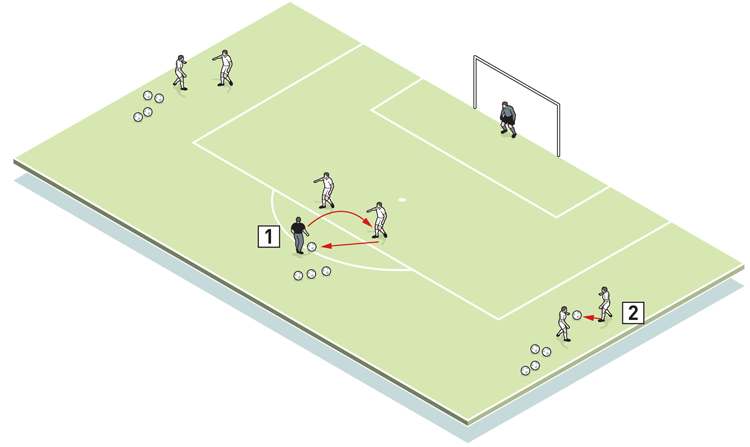
2. While the coach is serving to the striker, wingers play a pass and set-back for a cross
At the same time, the wingers combine to send a cross into the danger area and the attackers look to score (1b).
1b
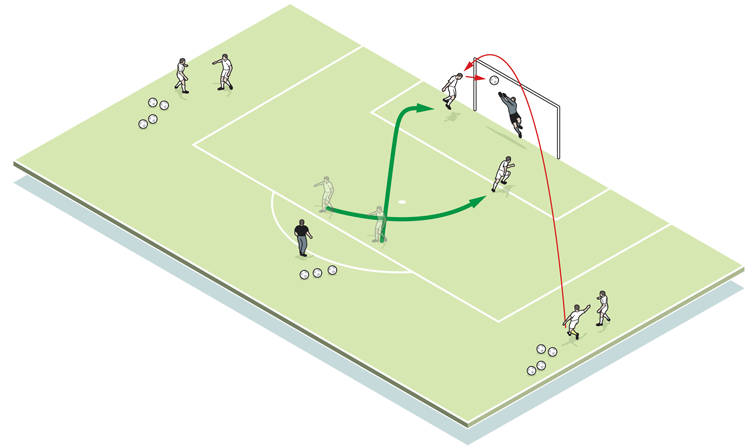
What are the key things to look for technically/tactically?
Although a simple set-up, the complexity here is in each attacker’s body shape and angle of run. For the forward to score when running in a rigid straight line to the middle of the goal, the ball has to be perfectly delivered to feet, something that cannot be guaranteed. Realistically, the shot will end up in the slip catching area on the other side of the goal (2).
Therefore, we encourage players to angle their run and shoulders towards where the ball is being delivered from. This makes it technically easier to make good contact with the ball.
2
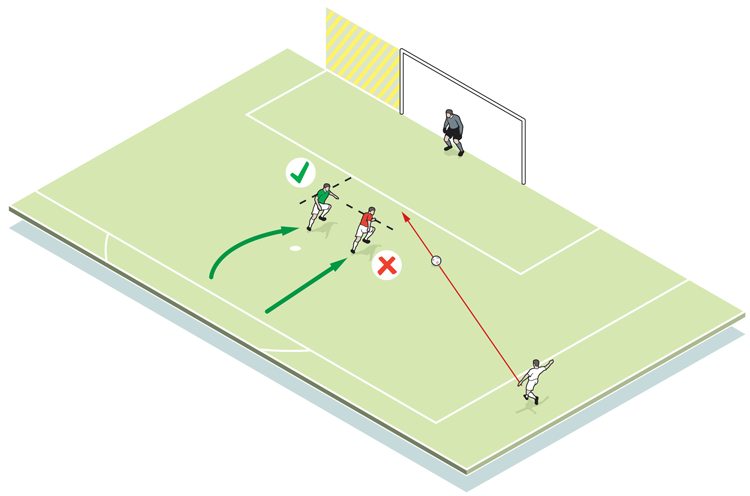
How do I progress the session?
We will have additional attacking pairs ready to go for each new phase and will experiment with a variety of crosses from both sides.
We might introduce a defender, but often find it’s better for the attackers to practise the skill unopposed before taking that into a small-sided game.
How would I put this into a game situation?
For a small-sided game, we create a 50x40-yard area with two 10-yard channels on either side, each containing two wingers. There is a 10-yard middle zone containing two midfielders from each team, with three defenders and two attackers in the zone in front of each goal (3a).
3a
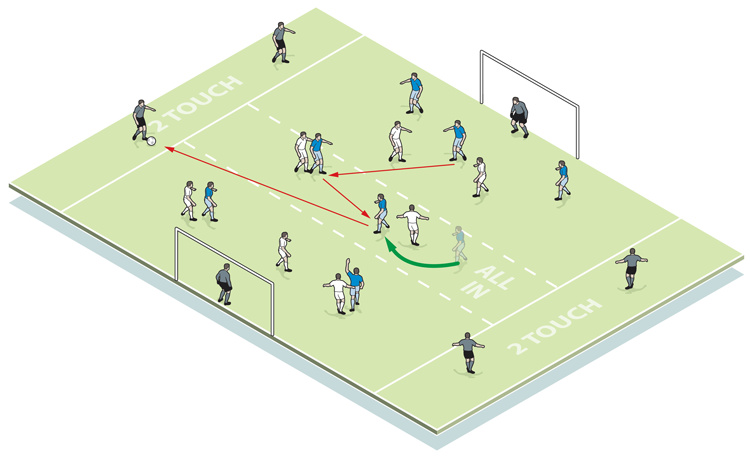
This game is 8v8 with four neutral wingers.
The one touch midfielders can progress out of their zone but attackers and defenders, who can have multiple touches, are fixed.
The ball should be fed out to a winger at the earliest opportunity – wingers have two touches to send it into the box (3b).
When the ball comes in, midfielders and the winger on the opposite side can move towards goal (3c).
3b
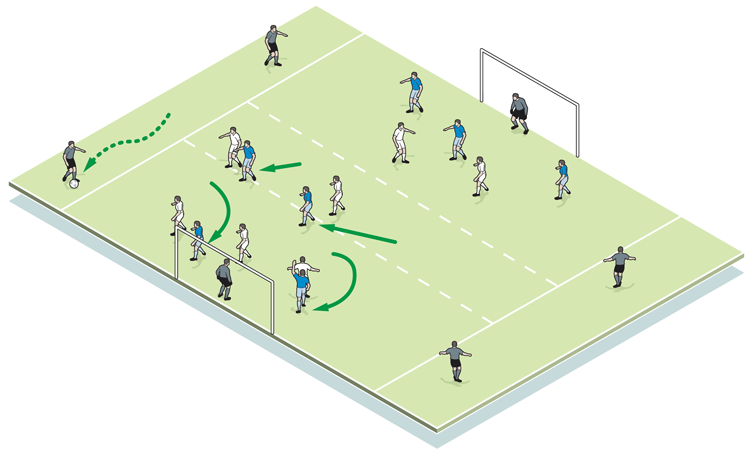
3c
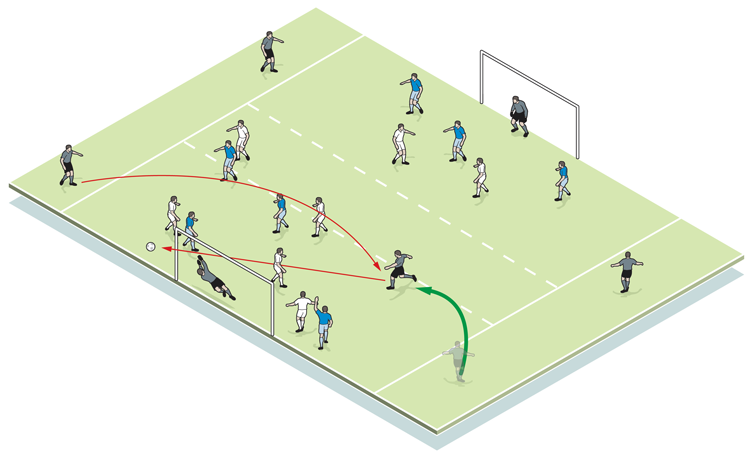
Related Files
Editor's Picks
Attacking transitions
Deep runs in the final third
Using the goalkeeper in build-up play
Intensive boxes drill with goals
Penetrating the final third
Creating and finishing
My philosophy
Pressing initiation
Compact team movement
Coaches' Testimonials

Alan Pardew

Arsène Wenger

Brendan Rodgers

Carlos Carvalhal

José Mourinho

Jürgen Klopp

Pep Guardiola

Roy Hodgson

Sir Alex Ferguson

Steven Gerrard
Coaches' Testimonials

Gerald Kearney, Downtown Las Vegas Soccer Club

Paul Butler, Florida, USA

Rick Shields, Springboro, USA

Tony Green, Pierrefonds Titans, Quebec, Canada
Join the world's leading coaches and managers and discover for yourself one of the best kept secrets in coaching. No other training tool on the planet is written or read by the calibre of names you’ll find in Elite Soccer.
In a recent survey 92% of subscribers said Elite Soccer makes them more confident, 89% said it makes them a more effective coach and 91% said it makes them more inspired.
Get Monthly Inspiration
All the latest techniques and approaches
Since 2010 Elite Soccer has given subscribers exclusive insight into the training ground practices of the world’s best coaches. Published in partnership with the League Managers Association we have unparalleled access to the leading lights in the English leagues, as well as a host of international managers.
Elite Soccer exclusively features sessions written by the coaches themselves. There are no observed sessions and no sessions “in the style of”, just first-hand advice delivered direct to you from the coach.







